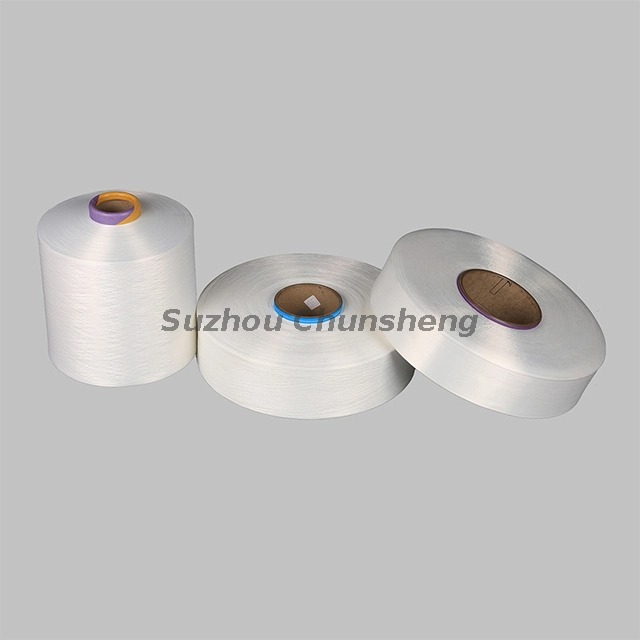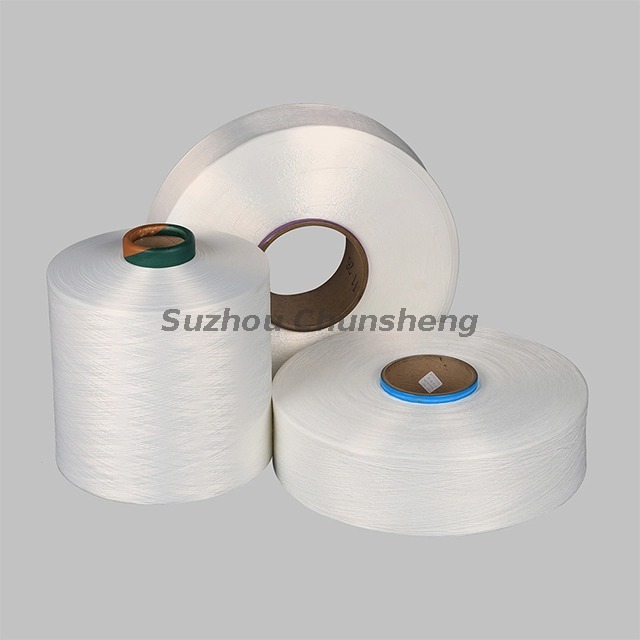T: +86-512-86871686
P: +86-13814898700
P: +86-13814898700
No.639 Yuanxin Road, Taoyuan Town, Wujiang, Suzhou, Jiangsu, China
Views: 175 Author: Site Editor Publish Time: 2025-09-24 Origin: Site
The fashion and textile industry is under growing pressure to reduce its environmental footprint, with sustainable materials taking center stage in innovation. Among the contenders, recycled polyester yarn has emerged as a widely adopted alternative to virgin polyester. Its increasing presence in sportswear, home textiles, and fashion collections reflects the urgent need for eco-friendly yarn that minimizes waste and conserves resources. However, whether recycled polyester yarn truly qualifies as eco-friendly depends on how it is produced, used, and disposed of. This article explores the sustainability profile of recycled polyester yarn in detail, comparing it to other eco-friendly yarns, analyzing its benefits and drawbacks, and offering actionable insights for businesses and consumers seeking greener textile choices.
Recycled polyester yarn, often labeled as rPET yarn, is made by processing post-consumer PET plastic bottles or post-industrial polyester waste into usable fibers. Instead of creating new polyester from petroleum, manufacturers reintroduce existing plastics into the textile supply chain. This process reduces reliance on virgin fossil fuels and diverts plastic waste from landfills or oceans.
From an eco-friendly yarn perspective, recycled polyester represents an effort to close the loop on plastics. By comparison, natural fibers like organic cotton, hemp, and bamboo offer biodegradable options, but they also require land, water, and energy resources. Recycled polyester yarn bridges a unique gap: it uses non-renewable resources already in circulation rather than extracting new ones. The key is evaluating whether this recycling cycle genuinely offsets environmental harm or simply postpones it.

Recycled polyester yarn brings several environmental advantages that support its eco-friendly yarn classification:
Reduction in Plastic Waste – Every ton of rPET keeps thousands of plastic bottles out of landfills and oceans.
Lower Carbon Emissions – Studies suggest that producing recycled polyester emits 30–50% fewer greenhouse gases compared to virgin polyester.
Energy Savings – Recycling PET requires less energy than extracting and refining petroleum for new polyester.
Circular Economy Alignment – Recycled polyester encourages re-use of existing resources, slowing down the production of virgin plastics.
| Benefit | Recycled Polyester Yarn | Virgin Polyester |
|---|---|---|
| Energy use | Lower | High |
| Carbon footprint | Reduced (30–50% less) | High |
| Plastic waste impact | Diverts from landfills | Adds new waste |
| Raw material source | Post-consumer plastics | Petroleum |
These benefits demonstrate why recycled polyester is marketed as an eco-friendly yarn. Yet, they are not the whole picture—limitations exist that influence its long-term sustainability.
Despite clear benefits, recycled polyester yarn is not a perfect solution. Several environmental challenges complicate its eco-friendly profile:
Microplastic Shedding – Like all synthetic fibers, recycled polyester sheds microplastics during washing, which end up in waterways and harm marine life.
Recycling Limitations – rPET is not infinitely recyclable. After multiple uses, fiber quality degrades, making it unsuitable for textile-to-textile recycling.
Chemical Processing – Depending on the recycling method (mechanical vs. chemical), the process can involve significant energy and chemical use.
End-of-Life Issues – Recycled polyester is not biodegradable, meaning garments eventually contribute to long-term waste if not properly disposed of.
This dual nature shows that while recycled polyester is more sustainable than virgin polyester, it may not meet the highest standards of eco-friendly yarns compared to natural biodegradable fibers.
To evaluate its eco-friendly status, recycled polyester must be compared against other yarns:
| Yarn Type | Biodegradable | Resource Use | Durability | Microplastic Risk | Overall Eco Profile |
|---|---|---|---|---|---|
| Recycled Polyester | Yes | Low energy | High | Yes | Moderate-High |
| Organic Cotton | Yes | High water | Moderate | No | High (if responsibly sourced) |
| Hemp Yarn | Yes | Low water | Very High | No | Very High |
| Bamboo Yarn | Yes | Moderate energy/chemicals | High | No | Moderate-High |
| Virgin Polyester | Yes | High energy | High | Yes | Low |
This comparison highlights that while recycled polyester yarn reduces plastic waste and energy use, it lags behind natural yarns in biodegradability. Still, for applications requiring durability and performance—like activewear or upholstery—it remains one of the most practical eco-friendly yarn options.
The eco-friendly yarn market continues to evolve with advancements that could improve the sustainability of recycled polyester yarn:
Chemical Recycling Improvements – Advanced methods break polyester down into raw monomers, enabling repeated recycling without quality loss.
Blended Fibers with Natural Yarns – Combining rPET with organic cotton or hemp reduces microplastic impact and improves biodegradability.
Closed-Loop Systems – Some brands experiment with take-back programs, reclaiming garments to recycle into new yarns.
Reduced Microfiber Shedding – Research into surface coatings and weaving techniques aims to limit fiber release during washing.
These innovations suggest recycled polyester yarn could grow closer to the eco-friendly yarn ideal with continued investment and technology adoption.
Recycled polyester yarn has carved a niche across industries because it balances sustainability with performance:
Fashion Industry – Widely used in sustainable collections for jackets, T-shirts, and dresses.
Sportswear – Chosen for durability, moisture-wicking, and lightweight qualities.
Home Textiles – Used in carpets, curtains, and upholstery where strength is vital.
Outdoor Gear – Popular for backpacks, tents, and sleeping bags due to weather resistance.
For businesses, integrating recycled polyester yarn communicates a commitment to sustainability while ensuring cost-effectiveness. For consumers, choosing products labeled with rPET supports waste reduction.

Not all recycled polyester yarn is created equal, so buyers should adopt careful practices:
Check Certifications – Look for GRS (Global Recycled Standard) or OEKO-TEX certification.
Evaluate Blends – Opt for yarns blended with natural fibers for better end-of-life outcomes.
Support Brands with Take-Back Programs – These reduce landfill waste and encourage circular fashion.
Wash Responsibly – Use filters or washing bags to reduce microfiber pollution.
These steps empower consumers and businesses to make informed, sustainable decisions when adopting recycled polyester yarn.
Recycled polyester yarn provides meaningful environmental advantages compared to virgin polyester, making it a viable choice in the search for eco-friendly yarn solutions. It conserves energy, reduces greenhouse gases, and tackles the global plastic waste crisis. However, limitations such as microplastic pollution and lack of biodegradability mean it is not a perfect solution. For performance-based textiles, rPET remains one of the strongest sustainable options, but pairing it with innovations, responsible practices, and alternative yarns can maximize its eco-friendly potential. Ultimately, recycled polyester yarn is eco-friendly in relative terms—better than virgin polyester, yet still requiring conscious management to achieve true sustainability.
Q1: Is recycled polyester yarn more eco-friendly than cotton yarn?
It depends. Recycled polyester uses less water and diverts plastic waste but sheds microplastics. Organic cotton is biodegradable but resource-intensive.
Q2: Does recycled polyester yarn shed microplastics?
Yes, like all synthetic fibers, it releases microplastics during washing, which is a major environmental drawback.
Q3: Can recycled polyester yarn be recycled again?
Mechanically recycled polyester has limited recycling cycles due to fiber degradation, but chemical recycling offers better long-term recyclability.
Q4: What certifications indicate eco-friendly yarn?
Key certifications include GRS, OEKO-TEX, and Bluesign, which verify recycled content and sustainable production.
Q5: Is recycled polyester yarn suitable for sensitive skin?
Yes, it is generally safe and hypoallergenic, though sensitive users may prefer natural yarns like organic cotton or bamboo.